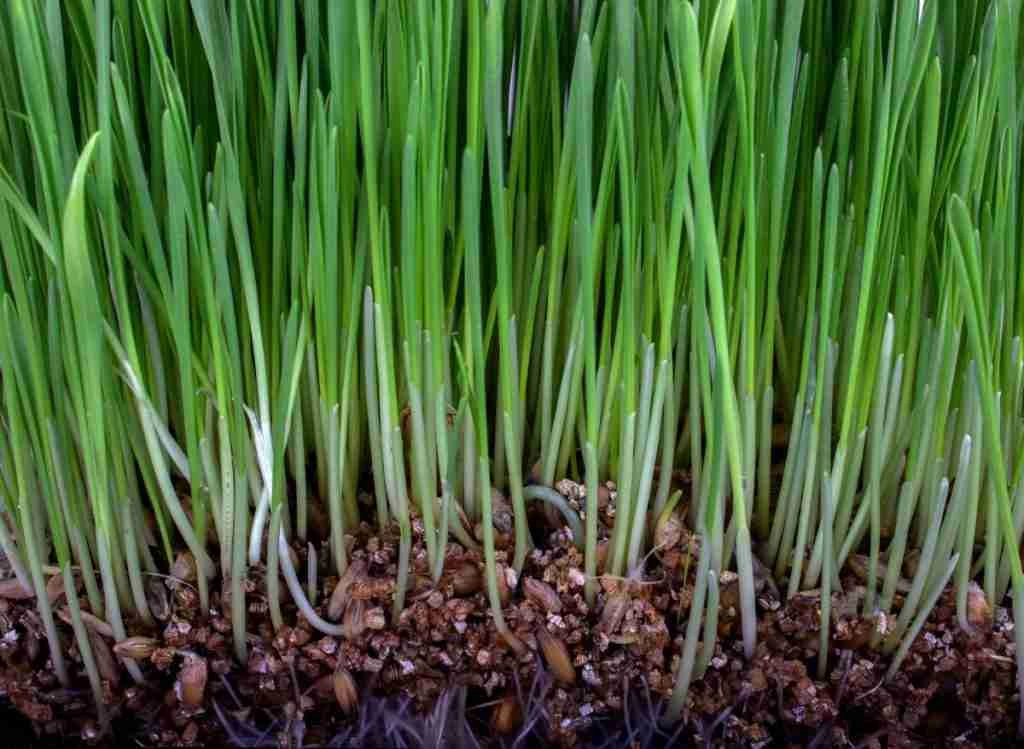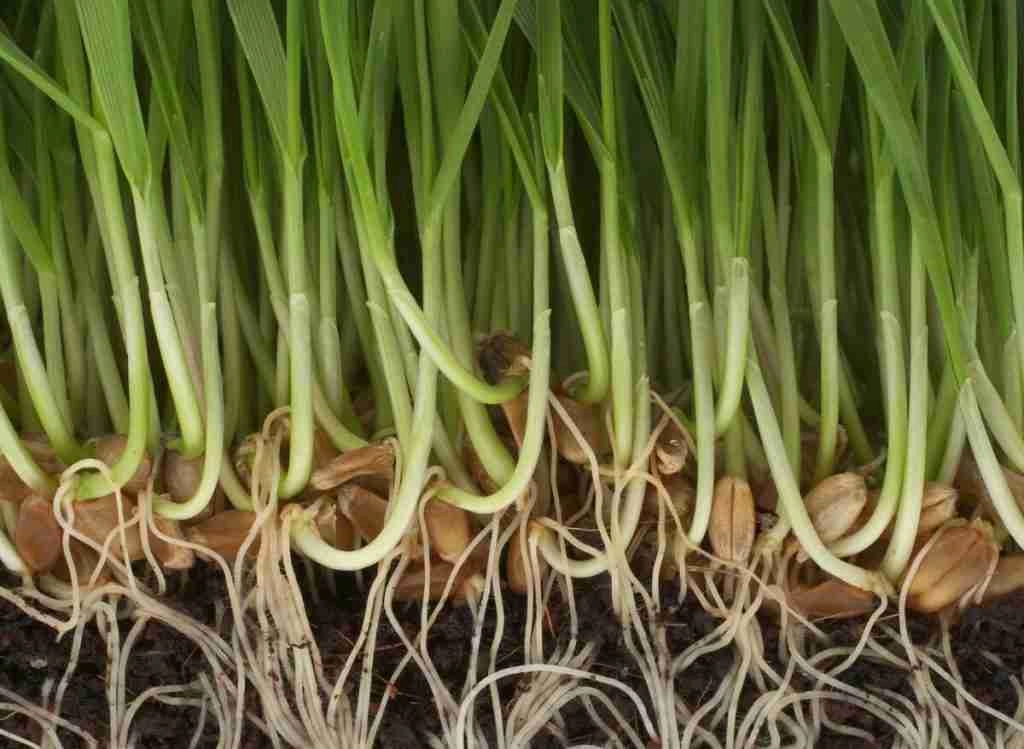This post contains affiliate links.

Depending on the type, grass seeds commonly have a small, oval shape. Unlike larger seed varieties, grass sprouts cannot push through a thick soil layer because the new growth is sensitive and tiny. But will grass seeds germinate on top of soil?
As a general rule, grass seeds will still attempt to grow on top of the soil; however, you will get poor results compared to grass seeds covered with 1/4 inch soil. Uncovered grass seed is likely to dry out, be eaten by birds, or be carried away by water runoff. In addition, it is also easier for uncovered grass seedlings to dry out and die.
In other words, covering the grass seed with a thin layer of soil or compost will get you more out of your grass seed than leaving your grass seed uncovered.
Read on to find out:
- Common reasons that prevent grass seeds from germinating on top of soil
- How to successfully and properly plant grass seed
- And helpful tips on choosing the best type of lawn grass
See also: How To Successfully Get Burnt Grass Green Again: A Quick Guide
Reasons That Prevent Grass Seeds From Germinating On Top Of Soil
There are various reasons why you shouldn’t leave your grass seed exposed to the elements. Grass seed grows as it absorbs moisture and produces a seedling ready for photosynthesis and germination.
Germination is the seed sprouting process and can take a few days to a few weeks to occur. For any type of grass seed to germinate, it needs specific conditions. You need your soil to be at the right temperature for germination and proper moisture.
Here are the top 4 reasons that prevent grass seeds from germinating on top of the soil.
See also: Best Ways To Deal With Too Much Iron In Your Garden’s Soil: A Guide
1- Root Development
Even if your grassroots germinate, they can still struggle to get adequately rooted, making them susceptible to damage.
Shallow roots in the ground may also prevent the grass from reaching moisture and nutrients below the surface.
Understanding root development will help you improve your grass seeds to grow healthier and more robust.

2- Grass Seed and Bird Food
Leaving seeds exposed increases their chance of being eaten by birds and prevents them from germinating on top of the soil. Instead, you can cover your grass to protect it from wildlife.
In addition, you can also feed the birds with birds food to distract them from devouring your grass. Remember, bird food is much cheaper than grass seed.
See also: 5 Hibiscus Plant Diseases You Should Look Out For!
3- Water Runoff
Heavy rainfalls are among the reasons why grass seeds will not germinate on top of the soil.
Grass seeds on top of the soil can quickly be swept up and carried to a sewer grate or even transferred to areas of your lawn where you don’t need extra grass seed.
Keep in mind that it takes about two to four weeks for the grass seed to germinate; during that time, the grass seed does not have roots to hold it in place when it rains.
See also: 5 Of The Best Companion Plants For Your Lantana Plants To Know About!
4- Improper Soil Preparation
The first step to successfully growing grass seeds is to start with proper preparation.
Start by testing the soil’s pH to determine if you need to add fertilizer to bring your soil to the ideal pH level between 6.2 and 7.0. Here is a link to a list of certified soil testing laboratories in the USA.
Inexpensive pH test kits are available online on Amazon or at your local hardware stores.
How to Properly Plant Grass Seed
Planting grass seed is a cost-effective and satisfying way to increase the green space around your home or improve your existing lawn. Here’s how to properly plant grass seeds.
Step 1: Pick The Proper Time Of The Year
Proper timing helps guarantee your grass seed will germinate properly, flourish, and remain healthy and strong. Generally, the best time to plant new grass is from mid-August to mid-September.
Planting grass seeds in late summer or early fall has many advantages over spring planting. The cool-season grass seed will germinate fast in the warm soil of late summer.
In addition, there will be less competition from weeds as fewer weed seeds germinate in late summer and early fall. After the grass seed successfully germinates, the warm fall days and cool nights encourage rapid grass growth.
See also: Can Actually Tomatoes Grow In Indirect Sunlight: Here’s The Truth!
Step 2: Get Your Soil Ready
The first step in planting new grass seed lawns is to grade your site correctly, ensuring that water drains away efficiently and allowing for easy mowing.
You need at least 4 to 6 inches of healthy soil to seed plant grass. If required, try to bring in additional topsoil or organic matter. And ensure that the topsoil or organic matter is weed-free.
How to Prepare Your Soil?
- Remove all construction debris, then fill in low spots and level off high areas.
- Test your soil. Proper soil pH is crucial to a healthy, thriving lawn. Most lawn grasses perform best when soil pH is between 6.0 to 7.5.4.
- You can also apply 10 pounds of a 10-10-10 fertilizer per 1,000 square feet and till it into your soil.
- The final step in soil preparation is hand raking the area, which can also be the last opportunity to establish the final grade. Immediately before seeding, apply a starter turfgrass fertilizer.
See also: 5 Things You Must Know to Make Gardening Easier for You
Step 3: Choose The Right Quality Grass Seed
Choosing the right quality of grass seed is an essential key to successfully establishing a new lawn by selecting high-quality grass seed that is best suited for your soil.
In sunny areas, Kentucky bluegrass is the best-adapted turfgrass. Choose a seed mix containing 3 or 4 bluegrass varieties. Use a combination containing about 50 percent Kentucky bluegrass and 50 percent fine-textured fescues in partially shaded areas.
For example, creeping red fescue, chewings fescue, and hard fescue are shade-tolerant grasses that form a beautiful-textured turf. In addition, they are medium to dark green and compatible with Kentucky bluegrass. You can also seed heavily shaded areas with fine-textured fescues.
When choosing grass seed, buy high-quality seed and avoid grass mixtures containing high percentages of perennial ryegrass.
Ensure your seed mix contains little or no annual ryegrass, weed seed, and inert material. The higher quality seed will be more expensive but should produce a thick, attractive lawn with fewer problems.
Step 4: Planting The Grass Seed
You can plant your grass seed by hand or with a drop-type seeder. The essential requirement is to distribute the grass seed over the area evenly. Plant half the seed in one direction and apply the other at a right angle to the first application.
After planting the seed, lightly rake or drag the area. Ensure that you cover the seed grass to a depth of 1/8 to 1/4 inch. Roll the area gently and lightly to ensure good contact between the seed and the soil.
See also: Bayer Grub Control Vs. Scotts Grubex: Which One Should You Choose?
Step 5: Water Your Grass Seed Adequately
Keeping seedlings and grass seeds constantly moist but not soaked is essential to successful grass-seeding efforts.
Aim to water newly seeded areas two to three times a day with a light spray to keep the seeds moist. And stop watering when puddles start to appear on the soil surface.
Once the seeds germinate and grass seedlings grow, then gradually transition to watering your lawn less frequently but more heavily. Reduce watering as the grass becomes taller and more mature.
Step 6: Watching Your Grass Seed Grow
Depending on the grass you are growing and other factors, including sunlight, site preparation, time of year, and average irrigation, germination takes five to 21 days. And expect your new grass to take another four to 10 weeks to root well and become established. It will take an entire season for most grasses to mature to the point where they are ready to withstand foot traffic.
After your new seedlings reach about 1 inch in height, check the newly seeded area for any empty spots or places you may have missed. Reseed the open spaces, and repeat the process as needed until new seedlings are thick and you are happy with the results.
Step 7: Mulchin, Mowing, and Lawn Maintenance
To promote your grass seed germination, try to mulch the area with clean and weed-free straw. Proper gardening tools, specifically mulching materials, help conserve soil moisture and prevent soil erosion and crusting of the soil surface.
One bale of straw should cover about 1,000 square feet of area. Once you mulch your soil, water the area thoroughly. After the first watering, irrigate the ground frequently and lightly. The goal is to keep the seedbed continuously moist and not allow the seedbed to dry out during the germination period.
After the grass begins to germinate, water less frequently but more deeply.
- You can start mowing your new grass when it reaches a height of 3 to 3 1/2 inches.
- Ensure the mower blades are sharp.
- Mow your grass at a height of 2 to 2 1/2 inches.
See also: Advantages And Disadvantages of Using Miracle Grow
How Long Does Grass Seed Take to Grow?
On average, it takes anywhere between 3 and 28 days for new grass seed to germinate. It also depends on where you reside, your climate, and the type of grass you plant.
Choosing The Best Type of Lawn Grass
To know if your lawn is warm-season grass or cool-season grass, ask yourself whether your lawn turned completely tan or brown last winter.
- If your lawn turns brown, you have warm-season grass like Bermuda grass, centipede grass, Buffalo grass, or zoysia grass.
- If your lawn stays somewhat green, you have cool-season grass, such as ryegrass, fescue, Kentucky bluegrass, tall fescue, or, most generally, a hybrid.
See also: How to Successfully Lower Manganese Levels In Soil
Different Types Of Cool-Season Grasses
Cool-season grasses successfully grow in areas where extreme temperature fluctuations generally happen without warning. Your lawn will freeze and go dormant during the winter season and turn a greenish-yellow until spring emerges.
| Cool-season grasses that grow fast | Time to germinate | Temperature required |
| Annual or Perennial Ryegrass | It takes about 5 to 10 days to germinate | Temperatures are generally between 50 and 65 degrees Fahrenheit (air temperatures between 60 and 75 degrees) |
| Kentucky Bluegrass | It takes about 7 to 10 days to germinate | temperatures are generally between 50 and 65 degrees Fahrenheit (air temperatures between 60 and 75 degrees) |
| Tall fescue | It takes about 7 to 12 days to germinate | temperatures are generally between 50 and 65 degrees Fahrenheit (air temperatures between 60 and 75 degrees) |
Different Types Of Warm-Season Grasses
Warm-season grasses can still thrive and survive in extreme temperatures but will be negatively affected by an extremely harsh winter. Warm-season grasses thrive best when temperatures are higher than 75º.
With proper maintenance and care, warm-season grass can make for a fantastic lawn. During the winter season, your warm-season lawn will turn a tawny brown (it might look like your lawn is dead). Don’t worry; your grass will recover and green up gracefully with spring rains and warm weather.
Generally, warm-season grasses will take more time to germinate.
| Warm-season grasses | Time to germinate | Temperature required |
| Bermuda grass | It takes about 10 to 30 days to germinate | Need soil temperatures between 60 and 75 degrees Fahrenheit (or daytime temperatures consistently above 80 degrees) |
| Zoysia grass | It takes about 14 to 21 days to germinate | Need soil temperatures between 60 and 75 degrees Fahrenheit (or daytime temperatures consistently above 80 degrees) |
| Centipede grass | It takes about 14 to 21days to germinate | Need soil temperatures between 60 and 75 degrees Fahrenheit (or daytime temperatures consistently above 80 degrees) |
| Buffalo grass | It takes about 14 to 30 days to germinate | Need soil temperatures between 60 and 75 degrees Fahrenheit (or daytime temperatures consistently above 80 degrees) |
Wrapping Up
As a rule of thumb, grass seeds will still try to grow on top of the soil, but cover your grass seed with 1/4 inch soil for better results.
Without protection, your grass seed is likely to dry out, be carried away by water runoff, or be eaten by birds. Always ensure that you choose grass seeds that suit your areas.


